| Designation: | EE-11 URUTU |
 |
|---|---|---|
| Manufacturer: | Engenheiros Especializados S.A. ENGESA | |
| Product type: | Armoured Vehicles | |
| Name: | Wheeled armoured personnel carrier |
The EE-11 Urutu armoured personnel carrier was designed by ENGESA from January 1970 with the first prototype completed in July the same year. After trials, a production order was placed for the EE-11 Urutu by the Brazilian Army which calls the vehicle the Carro de Transporte Sobre Rodas Anfibio, or CTRA for short, and production began at São José dos Campos in 1974.
The EE-11 shares many common components with the ENGESA EE-9 (6×6) Cascavel armoured car, which was developed from July 1970 and is also in service with the Brazilian and other armies. Production of all ENGESA armoured vehicles, including the EE-11 Urutu, is complete.
The ENGESA company is no longer trading, although large numbers of EE-11 Urutu armoured personnel carriers and EE-9 Cascavel armoured cars remain in service in many countries. Final deliveries of the EE-9 Cascavel were made to Colombia in 1992 together with EE-11 Urutu armoured personnel carriers.
The hull is of all-welded steel armour construction and consists of an outer layer of hard steel and an inner layer of softer steel roll-bonded and heat treated to give the maximum ballistic protection. The armour gives complete protection against small arms fire at point-blank range.
The driver sits at the front of the hull on the left side and is provided with a single-piece hatch cover, with three day periscopes fitted in the glacis plate forward of the hatch. If required, a windscreen can be erected over the driver's position when he is driving head out. The centre periscope can be replaced by a passive night periscope. Steering is power assisted and the steering wheel is adjustable according to the driver's position.
The engine compartment is at the front of the vehicle on the right side. The Detroit Diesel 6V-53T engine is coupled to an Allison Transmission MT-643 automatic transmission. The cooling system comprises a water-to-air radiator for the engine water, oil coolers for the engine and transmission and transfer case oils. Air circulation is forced through the engine compartment by a propeller shaft and driven fan. While swimming, the cooling is performed through a keel cooler with the air inlet and outlet louvres closed. The air inlet louvres are on the hull top to the right of the driver while the exhaust outlets are on the right side of the hull.
The troop compartment is at the rear of the hull and bench seats are provided down each side of the vehicle with an additional bench seat behind the driver's seat across the troop compartment.
There are two doors in the hull, one on the left side immediately behind the front axle and one at the back, which is hinged on the left side. The rear door is automatically operated by the driver.
Two arrangements of firing ports and vision blocks were marketed, five ball mount firing ports, two in each side of the hull and one in the rear door, and two glass bullet- and splinter-proof vision blocks in the side door; 11 firing ports, five on each side of the hull and one in the rear door, and five bullet- and splinter-proof vision blocks, one in the left door, one on the left side, two on the right side of the hull and one in the rear door. Four roof hatches over the troop compartment open towards the outside of the vehicle.
The main armament station is located behind the driver, slightly offset to the left of the vehicle's centreline. The basic Model EE-11 Urutu APC is armed with a ring-mounted .50 (12.7 mm) M2 HB machine gun, but the EE-11 Urutu could be fitted with many other types of armament installation including a ring-mounted 7.62 mm machine gun, a turret-mounted 60 mm TDA mortar and an ENGESA ET-90 turret armed with an ENGESA EC-90 90 mm gun. ENGESA developed three new turrets that could be fitted to the EE-11 Urutu armoured personnel carrier or the EE-3 Jararaca scout car. Brief details of these are:
- ENGESA ET-MD one-man turret armed with a 7.62 mm machine gun and a .50 (12.7 mm) M2 HB machine gun, both internally operated
- ENGESA ET-20 one-man turret armed with a 20 mm Oerlikon Contraves cannon and a 7.62 mm machine gun
- ENGESA ET-25 two-man turret armed with a 25 mm Oerlikon Contraves cannon and a 7.62 mm coaxial machine gun
The front suspension is independent and consists of double-wishbone arms, coil springs and double-action hydraulic shock-absorbers. The front wheels are driven by hypoid angular transmission and bevel differential gears. For amphibious operations, the front and rear axles can be pressurised. The rear suspension consists of semi-elliptical springs and double-action telescopic shock-absorbers. The articulated rear axle is the ENGESA 'Boomerang' type with walking beams and a differential locking system. The 'Boomerang' axles allow the wheels to travel 0.87 m upwards and downwards and ensure that all wheels are in constant contact with the ground. All tyres are of the run-flat type with an automatic inflation system. Disc brakes and planetary reduction gears on the wheel hubs are provided for all wheels. The two fuel tanks are situated either side of the hull rear and are filled from the top. The electrical system has a double 24 V system, a battery set is used for vehicle operations while a second set is just for engine start to avoid lack of power after long radio watch operations.
The EE-11 Urutu was originally developed for the Brazilian Marines, who required a vehicle capable of operating in heavy surf. This vehicle is propelled in the water by two propellers with kort-nozzles and is steered by two rudders at the rear of the hull, which are connected to the steering wheel. Before entering the water, a trim vane is erected pneumatically at the front of the hull by the driver. An air compressor integrated to the engine feeds three air reservoirs and all operating systems and accessories; brakes, transfer case, gear shifting, tyre inflation, rear door and amphibious elements.
It has a maximum water speed of 8 km/h and, in addition to the electric bilge pumps, a hand-operated emergency bilge pump is provided. The EE-11 Urutu is also equipped with disc brakes and an automatic tyre inflation system.
Optional equipment originally marketed for the EE-11 Urutu included night vision equipment, various radio installations, a winch with a capacity of 5,000 kg and a Mercedes-Benz OM-352A (190 hp SAE) engine coupled to an Allison Transmission MT-643 in place of the standard Detroit Diesel 6V-53N diesel developing 212 hp. The EE-11 Urutu could be delivered fitted with an NBC system.
Mounted in the hull rear is an 81 mm mortar firing through the roof of the vehicle. A 7.62 mm machine gun is fitted for local protection. The mortar can be elevated from +40 to +80° and if required can be dismounted from the vehicle and used in the ground role.
This model is unarmed, has a higher roof and can carry between six and eight walking wounded or a smaller number of stretcher cases. Standard equipment includes an air conditioning system, breathing equipment and a refrigerator for storing medicines. It can also be equipped with four stretchers. Colombia is known to have a quantity of these vehicles in service.
When being used for cargo, the EE-11 can carry 2,000 kg. Larger loads would be loaded through the rear doors, while smaller loads could be loaded via the roof hatches.
The ENGESA EE-11 Urutu AFSV is an amphibious Armoured Fire Support Vehicle fitted with the ENGESA ET-90 two-person turret armed with the ENGESA EC-90 90 mm gun. This model has a crew of eight: driver, commander, gunner and five infantrymen who are seated at the very rear of the hull. A total of 48 rounds of 90 mm ammunition is carried, 12 rounds of ready use in the turret and 36 rounds in the hull. The turret could be fitted with a power traverse system and a gunner's sight with an integral laser range-finder. The first customer for this was Tunisia. In mid-1988, Venezuela placed an order for the supply of 100 EE-11 Urutu APCs including some in the Armoured Fire Support Vehicle configuration. This turret is the same as that fitted to the ENGESA EE-9 (6 × 6) armoured car.
Basic vehicle fitted with radios and all the modern requirements for a command post.
This model has different roof hatches to permit personnel to work standing upright and is fitted with a front-mounted winch, a hydraulic crane, an oxy-acetylene welding machine, a portable generator, an electric welding transformer, an electric grinder, a complete range of tools and specialised equipment and a tent.
The ENGESA EE-11 Urutu in the riot control and internal security operation version has the same basic features as the EE-11 Urutu armoured personnel carrier and retains the same mobility and ballistic protection. Mounted at the front of the vehicle is a blade for clearing obstacles.
Some vehicles used by Jordan have been fitted with an armoured shield for a .50 (12.7 mm) M2 machine gun that has been developed by the King Abdullah Design and Development Bureau.
|
||||||||||||||||||||||||||||||||||||||||||||||||||
|
|||||||||||||||||||||
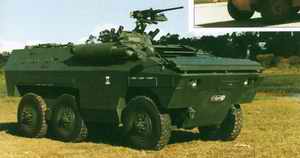 |
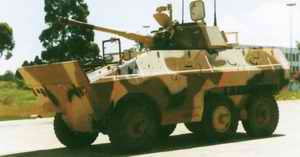 |
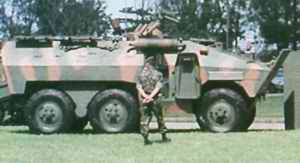 |
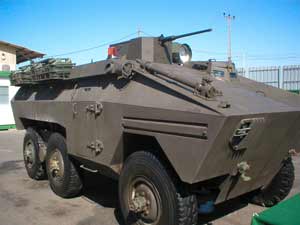 |
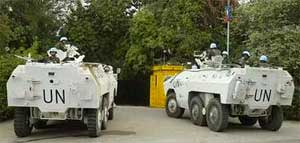 |
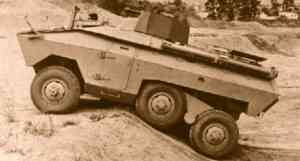 |
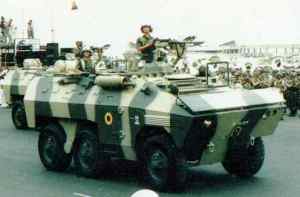 |
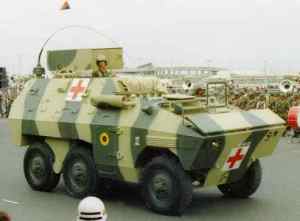 |




















